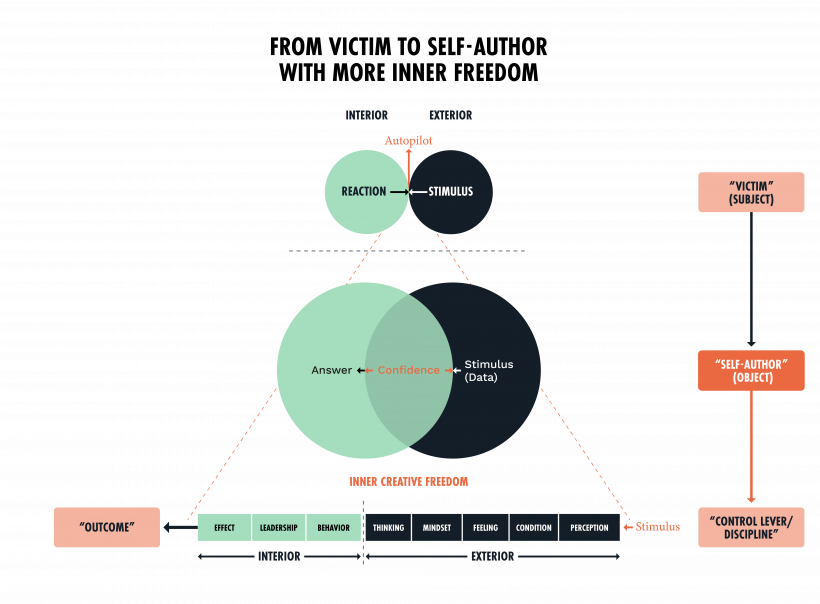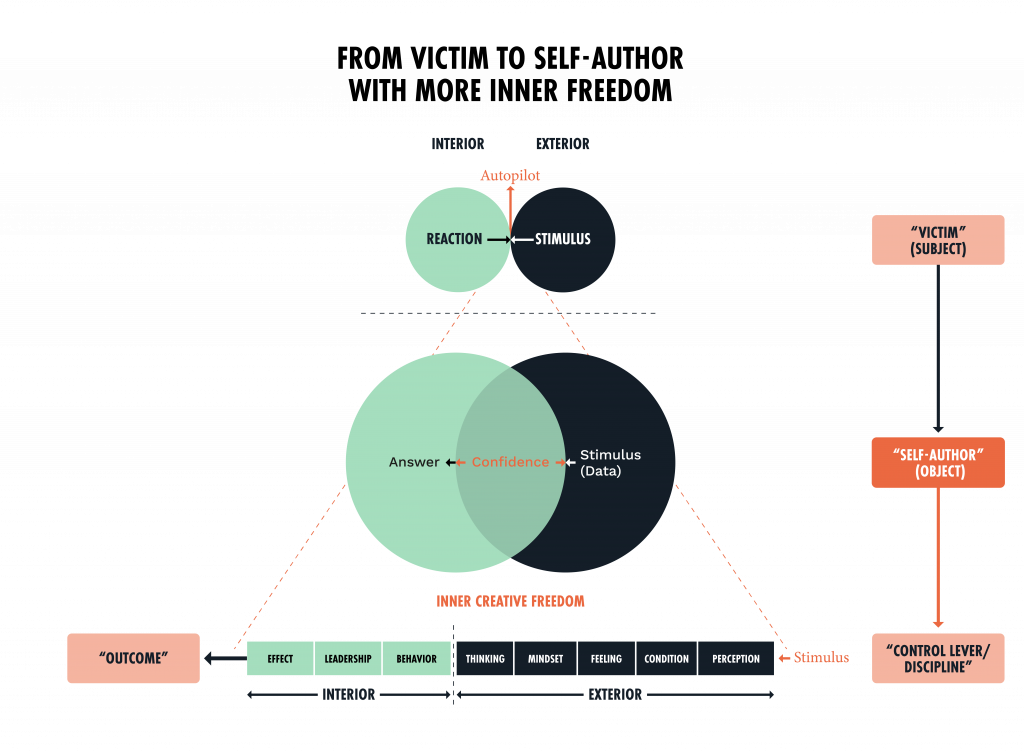02 The first step: From adaptor to self-author

Dear Transformers, dear Co-Creators, dear creators of a new time!
Many of us want to play an active role in the great transformation. Want to make a positive difference in the world as a “self-author” – and do so out of inner conviction, equipped with an inner North Star, as an authentic leader of tomorrow.
The word “self-authorship” comes essentially from Harvard psychologist Robert Kegan, who has focused on adult self-development for over 40 years (Vertical- Adult Development). By this he means the attitude: I take responsibility for myself, I rewrite my own story every day. I am the author of my life. This is a natural (but very advanced) leap of consciousness in human development and maturity, at the threshold of which many leaders and their teams find themselves.
This leap from “Achiever” to “self-authorship” is THE critical mindshift. Before, the outside ruled and orientation: I achieve the goals of others, I adapt to the external world. But after that, the inside guides us: “I orient myself to my own values, my inner North Star”.
This is also called the subject-object-shift: Before is my ego, my I, just as it is. (subject). But afterwards the state is completely different: I shape it as an object, it is an open becoming, a journey to more and more authenticity. This inner maturity, self-reflection and work on oneself are at all the basis for real decentralized ownership, for inner ownership of any roles and projects, for authentic leadership in change. And this is exactly what “agile” calls for everywhere today. But if someone has no inner support, it will be difficult for him or her to take on personal responsibility or to be a solid leader in change. Instead, they will always think: You decide for me, tell me what is right. Or: Authentic for me is what is cool right now and for what I get my “likes” in life.
Only those who rest in themselves, who have a genuine relationship with themselves, can let go of external structures and old authorities even in times of change and look for new, more meaningful ones. Because he is no longer attached to the outdated. (After all, one is hung up on others in organizational charts :-)) This is the basis for transformative leadership.
But the reality is often different: We are on autopilot, acting as stimulus-response machines.
Today we find ourselves far too often in stimuli (100 emails, SoMe, Netflix,…) and in tension (30 projects at the same time, eight zoom meetings per day, high goals). We are under pressure coming from the outside. Even in top management, we see ourselves as “Achievers” who have to reach goals set from the outside and can’t from the inside.
So our focus is only outward and our nervous system is activated in the so-called sympathetic fight mode (fight, flight, submission). The sympathetic strand of our nervous system activates us, it makes us awake and alert and gives us adrenaline. This enables us to ward off danger or to achieve something in the outside world (success, goals, survival).
Transformation doesn’t happen that way, of course. Because our evolutionary nervous system allows openness, reflection only when we feel safe, have energy and take mental time for it. By the way, we really learn during sleep, when we rewire what we have experienced in deep or REM sleep, both physically and mentally. So we need more time for sleep (7-8 hours) or time for ourselves during the week, early and in the evening, on weekends, quarterly and annually, to work on ourselves and with ourselves and to develop real self-awareness.
It sounds trite, but it’s not. Because let’s face it, for most, the opposite is true: the world has me in its grip. I run after tasks and duties. I try hard to meet all the requirements. A study by Mercer, a management consulting firm, concluded that 81 percent of employees in the U.S. deal with burnout or similar mental health issues. Two-thirds said their ability to work has been impaired as a result.
If you want to develop your true strengths, you can’t run behind, you can’t always just get everything done, you can’t always be on your last legs. We want to surf at the front of the wave, not sink behind it.
The free space of “sovereignty”.
For this to succeed, we establish an inner system, a free space of sovereignty, which is switched between stimulus and reaction. Because this is exactly what is usually missing in everyday life. An external stimulus comes along, such as criticism or a bad mood from the boss, and we immediately have an internal reaction: anger. Anxiety. Sometimes anger. For example, a colleague in a conference dumps a task on me that is far too big. I involuntarily react immediately irritated, offended, either become loud or retreat inwardly. I later do the job reluctantly and uninspired. It all happens as if automatically, as if it’s not even fully conscious.
It isn’t – to make it really conscious, I need the inner space between stimulus and reaction. So that an autopilot reaction becomes a conscious response. Which I then also take responsibility for.
This space exists in the natural sequence of how external stimuli are processed in us. They are at the same time the levers for conscious development and self-authorship. I explain them in detail in the Transformation Code. In the brevity that is possible here,
- Perception: First, I can consciously perceive and sharpen all my senses. They are the access to life. If you feel and see little nothing, you can act per se only roughly template.
- The inner energy state: It makes a huge difference whether I have energy or am drained. Either I react to feedback sullen and closed or I can accept it well charged. Am I awake or tired, open or closed?
- The emotion, the feeling: Do I have access to it at all? Can I categorize external stimuli well? Can I clearly sense what feelings they trigger in me? Can I perhaps even consciously regulate myself in order to play effectively as a leader with the E-motion as “Energy in Motion”?
- The Mindset: A reaction e.g. to a woman in management also depends on my attitude (“equal”) and origin (culture, religion). And also on whether I know that the beliefs are rather self-made. And therefore also changeable. For me the most powerful key to personal growth, next to Bodywork.
- Thinking: Only after Mindset do conscious maps and models of thinking come into play. If I know them at all, I can play them out situationally at will. Do I know my own biases? It’s about the biases, the rules of thumb that I use to make quick decisions. (For example: digital is always better than analog, the majority is right, Germany is morally better and superior).
- Action: Can I then take clear and concentrated action or respond to the stimulus consciously without fear. Or, as a leader, exemplify my role model.
- Leadership: Only in seventh place in the space of sovereignty can I effectively give direction to the energy through leadership, by giving feedback, asking questions, enabling decisions, or telling a story of change.
- Impact: This is where the impact of me comes in. Not just on the job. Also through family, friends, colleagues, organization, society, and the world.
We can work on all eight points. These are the levers by which we can grow, we can unhinge the world. Thus, starting with inner work, we can expand the space of sovereignty step by step, giving more and more of our story its own meaning. We can make a difference in the world. It doesn’t start in the culture or leadership workshop, but with a self. In the body, through emotion, mindset into clear action. Only then can I think about leadership of others.

Sometimes people (mainly in Germany) misunderstand my idea and say to me, “It’s all just self-optimization.” Is that true? Are we all self-optimizers now? No! It’s not about becoming a better and better oiled cog in a big machine. Ask yourself: Are you working against your human nature or with it? Because we all work. The processes that torment us often enough are already running anyway. I only encourage you to take them in hand now and to control them consciously and to change them sensibly.
Ask yourself:
Is your mode still “Survive”? – Replace that with: Thrive!
Are you still a victim of the circumstances? – Become a self-author!
Do you feel like you’re dead inside? – Learn to be a live player!
Of course, all this does not happen overnight. The gods have put training before success. But if you set out on the path, you will be inspired from the very first day. The new connections in the brain are formed only gradually. But the old adage holds true: The journey is the destination. Because this path brings joy. Because when we overcome our own limitations, we are in the flow. We feel good and are completely in the moment and master the situation.
If you don’t know how to get started, I’m going to give you three pieces of advice. First, take back control of your calendar. Get rid of the unnecessary and set aside time for yourself – that always works, whether you’re a CEO or a young professional. I know this because we’ve tried it many times and had great success with it. Second, use your breathing consciously. It is the first and most important technique of self-regulation. (See “Practices” below for two tricks with instructions.) Third, get your sleep in order. If you are tired, you will never move mountains. If you need help with this, book a training with us. But you can start immediately, today, right now.
Yours,
Achim

